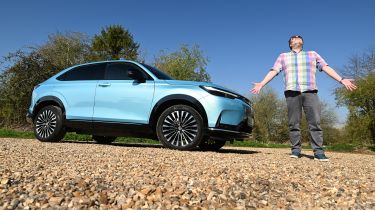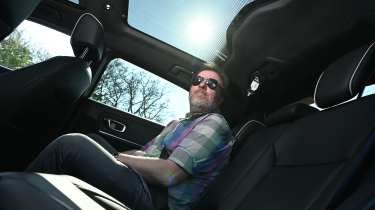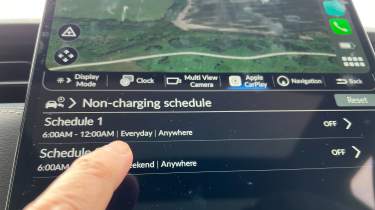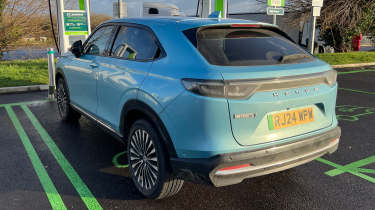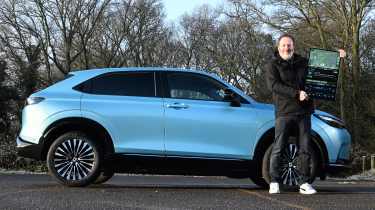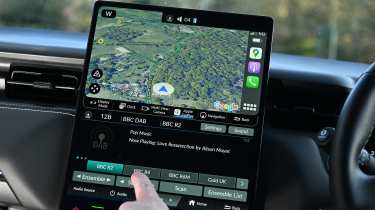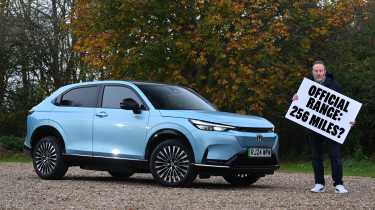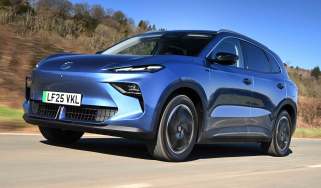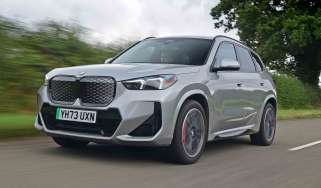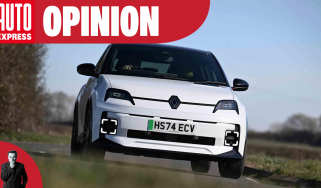Honda e:Ny1 Advance long-term test: small SUV thrives in the summer sun
Final report: recent sunnier, warmer weather has suddenly given our electric Honda a new lease of life

Verdict
The sunny weather has transformed the Honda e:Ny1 into a EV that’s usable every day, thanks to the dramatic improvement in its efficiency. It still lags behind many of its small SUV rivals, though, and winter will bring plenty of range worries.
- Efficiency: 3.0 miles/kWh
- Mileage: 13,024
If you think I’m going over old ground by talking about the Honda e:Ny1’s range and efficiency then I apologise, but it’s simply the biggest factor to consider when thinking of switching to an electric car.
I’ve been plagued by horrendous inefficiency in the Honda, which even dropped below 2.0 miles per kWh during exceptionally cold periods over the winter.
But hallelujah, the sun has come out and the e:Ny1 is enjoying the spring weather even more than the hundreds of daffodils that have made a welcome appearance. I know EVs are far better suited to the warm, but I’ve never seen such an increase in efficiency from a temperature jump of a few degrees. It’s such a marked improvement that I find myself looking to the skies and praying for warm weather whenever I need to head out.
The sun’s rays mean that the e:Ny1 is now regularly getting above 3.0 miles per kWh and, on one particularly balmy evening, I was stunned to see it show 3.6 miles per kWh. It’s the kind of figure the Honda should have been hitting from the start, and one that actually makes it a pretty usable day-to-day EV.
Used - available now

2022 Vauxhall
Mokka
32,005 milesManualPetrol1.2L
Cash £13,264
2024 Mercedes
EQB
39,188 milesAutomaticElectric
Cash £24,836
2023 FORD
TRANSIT CUSTOM
42,694 milesManualDiesel2.0L
Cash £18,390
2023 FORD
TRANSIT CUSTOM
43,720 milesManualDiesel2.0L
Cash £18,249Now, before I get too carried away, it’s worth noting that e:Ny1 is still far less efficient than some of its main rivals. The peak 3.6 miles per kWh I achieved is some way short of the 4.1 miles per kWh that deputy editor Richard Ingram averaged over six months in a Peugeot E-2008, or the 4.5 miles per kWh we achieved in a Jeep Avenger.
Nevertheless, the boost in efficiency has been a welcome surprise, and it’s almost a shame that it’s time for the Honda to go back. I’ve done more than 13,000 miles since the car arrived on our fleet in October and the literally daily charging that was necessary over the winter months was really placing a strain on my finances. Many people buy an electric car because they think it’s going to cut their running costs, but if the efficiency isn’t there, then the cost savings plummet.
Another thing I’ve been struggling with in the e:Ny1 whatever the weather is getting its power down. It’s incredibly easy to spin the wheels with a prod of the accelerator, which can be frustrating when you have to pull away from a junction. Many times I’ve thought there was a big enough gap to pull into, only for the Honda to struggle for traction; then the approaching cars suddenly appear worryingly large in the rear-view mirror.
It’s also quite disconcerting because it feels like you’re losing control if you accelerate really hard. When I put the car into Sport mode, I pretty much get the wheels spinning with even the slightest touch. Then again, I’ve prioritised range over anything else, so the car has barely been out of Eco mode.
Despite its foibles, the e:Ny1 has been a pretty good servant as a family load-lugger. My two kids have really put the interior’s durability to the test and for the most part it’s passed with flying colours. There are certainly plenty of clever touches – such as the ability to put individual child locks on with a simple flick of a switch on each door – that families will really appreciate.
The huge glass roof lets in lots of light during the winter and can be covered during the sunny days so the cabin doesn’t get too warm. The rear half does require manual shade panels to be put in place, which is more of a chore than simply pulling a blind across, but they still do the job. Space in the rear isn’t exactly plentiful, but it’s adequate and you never really feel cramped inside.
The synthetic leather seats that come as standard across the range are a bit of an issue, though, because they have proved so hard to clean. They are also easily marked, especially because I still use child car seats. These leave a noticeable indentation and, because I move them about regularly, it’s a bit of an eyesore seeing where they were before. Small crumbs also have a tendency to wedge themselves in the perforations, and require some vigorous hoovering to dislodge.
Honda e:Ny1 Advance: third fleetwatch
Off-peak ambitions are stalled by backwards logic
Scheduling an electric car to charge overnight should be a simple process, right? Not so when it comes to the Honda e:Ny1. I’ve switched to an EV-focused energy tariff and was hoping to take advantage of some cheap off-peak electricity, but I simply couldn’t get the car to play ball. I was about to give up when I noticed the Honda’s display shows ‘non-charging schedule’. In other words, you have to tell the e:Ny1 when NOT to charge!
Honda e:Ny1 Advance: second fleetwatch
The e:Ny1’s real world winter charging rate drives us round the bend
I’ve been racking up the miles in the Honda e:Ny1 and, as a result, I’ve been spending plenty of time at public chargepoints. It’s supposed to charge up to 78kW, but the most juice I’ve seen it suck in is a rather disappointing 57kW. It wouldn’t be such an issue if it didn’t need to be topped up so often, but it only has a real-world range of 125 miles in the winter. Any sort of longer trip requires a one-hour stop for every two hours of driving. Not great!
Honda e:Ny1 Advance: second report
While the giant touchscreen and the tech behind it are major highlights, the Honda e:Ny1 continues to be held back by its poor efficiency and high running costs.
- Efficiency: 2.2 miles/kWh
- Mileage: 7,455
The Honda e:Ny1 has a party piece that never fails to impress. I’ve heard the words “wow, look at the size of that screen” from almost everyone who has sat inside, and there’s no denying that the giant 15.1-inch portrait display dominates the cabin.
Although its size is impressive, the more I use it, the more I appreciate its brilliance. I’ve read some owners have been slightly disappointed that the screen can’t just show one huge sat-nav map etc, and is instead only able to be used in three separate parts, but that’s exactly what makes it stand out to me.
The top third is either your navigation or Apple CarPlay/Android Auto control. The middle section displays media, car settings and other menu options, while the bottom portion is solely for the climate controls. This means that everything is at your fingertips when you need it. There’s no prodding away at the screen trying to find the correct menu to change the radio station while you’re on the move – it’s all right there and ready to go.
Another huge advantage is that you can double up on Apple CarPlay. If you’re using Google Maps for navigation, you can keep all the information on the top screen, while changing the podcast you’re listening to on the middle section. It’s a very handy feature.
I’m amazed other car companies haven’t done something similar. There’s a constant debate in the Auto Express office about the merits of touchscreens and physical controls, but it feels like the e:Ny1 provides the best of both worlds. It’s perhaps not quite as simple as turning a dial, but it’s the next best thing.
While the screen has been a great asset, the Honda really does suffer from an Achilles’ heel. As I mentioned in my first report (below), I was shocked at how inefficient it is, and it’s got worse as winter has taken hold. With temperatures regularly plummeting below zero recently, the e:Ny1 has gone from averaging 2.6 miles/kWh during its time with me so far to just 2.2 miles/kWh. In fact, because I was keen to know just how bad it is, I reset one of the trip computers… then watched, alarmed, as it dropped to 1.6 miles/kWh on a particularly cold morning.
As a result, I’m having to carefully plan longer journeys and resort to regular public charging, something I’d managed to mostly avoid in the past. On a recent trip to Cardiff from West London, I had to stop three times for a top-up. Thankfully there were charging bays available each time, but this highlighted another of the Honda’s issues – charging speed. It can only draw in a maximum of 78kW, so I’ve spent a lot of time waiting around for the battery to be replenished.
Lots of public charging also means it’s costing me significantly more to run than I anticipated. I’ve calculated I’m paying around 40p per mile thanks to a real-world range of around 125 miles and charging costs of 79p/kWh. So much for low EV running costs! I’ve had numerous E-mails from readers complaining of similar issues and how it’s costing them so much more to run than they expected. Most sign off by stating they won’t return to EV power any time soon.
To highlight the issue, senior photographer Pete Gibson is currently running a Skoda Superb diesel, and he’s getting 800 miles from a full tank – meaning running costs of less than 12p per mile (thanks to a 66-litre
fuel tank and £1.44 per litre diesel prices). It just goes to show the difference!
The e:Ny1 was due to go back to Honda after three months with us, but I feel it deserves a second chance during potentially warmer weather. The firm has agreed to an extension, so let’s see what spring brings and if the car can get closer to its official 256-mile range.
Honda e:Ny1 Advance: first fleetwatch
The Honda e:Ny1's boot size trails rivals such as the Hyundai Kona Electric
I’m preparing for a house move, so the Honda e:Ny1 has been helping me to palm off all the tat I no longer want on unsuspecting friends and family. However, it’s become clear that the Honda’s boot is really rather small. At just 344 litres, it’s way down on some of its electric SUV rivals, such as the Hyundai Kona Electric (466 litres). Add a few boxes and a couple of bags and it’s bursting at the seams, meaning multiple trips are often needed.
Honda e:Ny1 Advance: first report
We like many aspects of life with Honda’s electric family SUV, but its disappointing efficiency is a cause for concern
- Efficiency: 2.6 miles/kWh
- Mileage: 5,180
Hear the words ‘electric car’ in a conversation and it’s not long before the word ‘range’ is mentioned, because many people are fixated on just how far EVs will go on a single charge.
I have been an electric convert for the past couple of years, though, and as a result it’s something that has worried me less and less over time, especially as many modern cars now have bigger batteries and are, in theory, becoming more efficient. The more you drive an EV, the more you get used to how they perform and plan journeys accordingly. Range anxiety is almost a thing of the past.
But I’m now finding range dominating my thoughts once again and it’s all down to the latest arrival on our fleet: the Honda e:Ny1. Before taking the keys, I was quite pleased to see it boasted an official WLTP figure of
256 miles from its 62kWh battery, and was looking forward to taking plenty of stress-free trips to see family and friends down the M40 motorway. But the reality is quite different.
When the e:Ny1 was delivered, I plugged it in and left it to fully charge. A few hours later, I was quite surprised to see the quoted range showing just 183 miles. Where did those 73 miles go? I thought the figure would surely start to rise with some careful driving around town. But instead of improving, the situation has become even worse.
I’ve now been driving the Honda for a couple of weeks, covering more than 500 miles in the process, and it’s only returned 2.6 miles per kWh so far. If it continues like that, I can expect a range of just over 160 miles in reality.
It’s no secret that electric cars regularly fail to get close to WLTP figures, but it’s not always the case. Chief sub-editor Andy Pringle, for example, is currently running a Genesis GV60, and he recently managed to achieve almost 6.0 miles per kWh on a trip through London. That’s more than double what I’m getting and a figure I can only dream of!
If the e:Ny1 is this inefficient now, what will it be like when the colder weather hits? Will I have enough range to even get to Oxford and back from my home in West London (a trip of just over 100 miles) without having to stop for a top-up? All questions I’ll be answering over the coming months, but it’s certainly left a fair few doubts in my mind.
I contacted Honda to see if the figures I am seeing are an anomaly. I was told: “This sounds about right and to be expected due to the time of year and ambient temperature, causing the battery efficiency to drop off slightly.”
But it feels a little harsh to focus so hard on the e:Ny1’s efficiency, because it’s otherwise been a great car. I really like the way it looks and, although the colour has caused some debate, the overall design is modern. It’s very distinguishable as a Honda, but that’s no bad thing, with so many other bland SUVs around.
With a family of four, I was also pleasantly surprised with the space on offer, especially in the back. Rear legroom is impressive, with a big area for the kids to swing their legs around without kicking the front seats. The illusion of space is also helped by the airy cabin.
The glass roof lets people in the front and back bask in the sunshine when it appears. The only niggle is that the rear section has removable cover panels, rather than a rolling blind. They are slightly fiddly to take out.
In general, the interior quality feels good, with lots of soft-touch materials and no hints of any creaks or rattles, although the piano- black materials used around the centre console are already showing signs of wear.
The showstopper is undoubtedly the huge 15.1-inch central portrait screen. Although I’m not a fan of touchscreens in general, the Honda’s is a fine example of how to do it right, with everything available at your fingertips. There’s no need to scroll through menus while driving to turn the heater up, for instance.
| Rating: | 3.5 stars |
| Model: | Honda e:Ny1 Advance |
| On fleet since: | November 2024 |
| Price new: | £42,845 |
| Powertrain: | 68.8kWh battery (62kWh usable), 1x e-motor, 201bhp |
| CO2/BiK: | 0g/km/2% |
| Options: | Metallic paint (£650) |
| Insurance*: | Group: 40 Quote: £1,682 |
| Mileage: | 13,024 |
| Efficiency: | 3.0 miles/kWh |
| Any problems? | None |
*Insurance quote from AA (0800 107 0680) for a 42-year-old in Banbury, Oxon, with three points.

